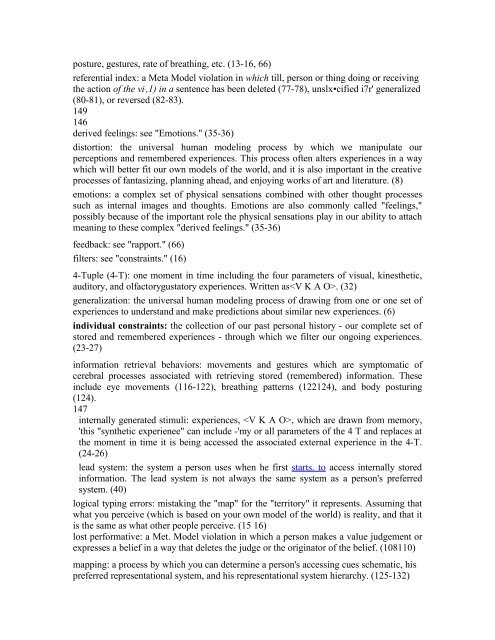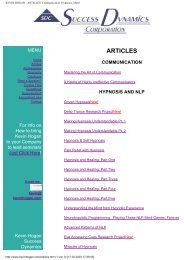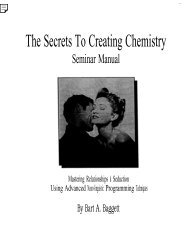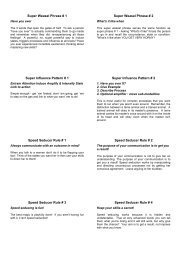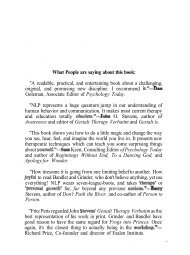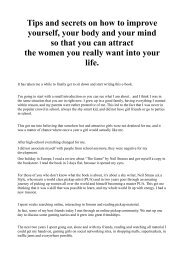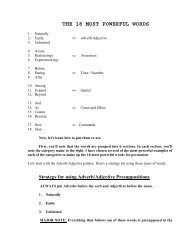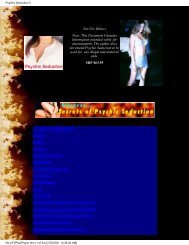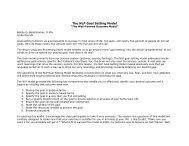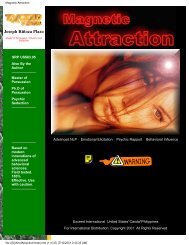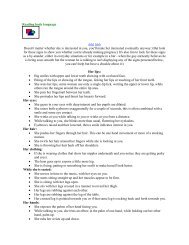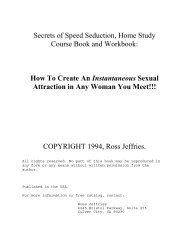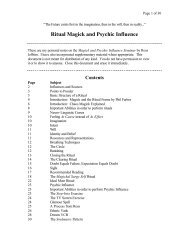A Pragmatic Guide To Communication & Change.pdf - NLP Info Centre
A Pragmatic Guide To Communication & Change.pdf - NLP Info Centre
A Pragmatic Guide To Communication & Change.pdf - NLP Info Centre
- No tags were found...
Create successful ePaper yourself
Turn your PDF publications into a flip-book with our unique Google optimized e-Paper software.
posture, gestures, rate of breathing, etc. (13-16, 66)<br />
referential index: a Meta Model violation in which till, person or thing doing or receiving<br />
the action of the vi , ,1) in a sentence has been deleted (77-78), unslx•cified i7r' generalized<br />
(80-81), or reversed (82-83).<br />
149<br />
146<br />
derived feelings: see "Emotions." (35-36)<br />
distortion: the universal human modeling process by which we manipulate our<br />
perceptions and remembered experiences. This process often alters experiences in a way<br />
which will better fit our own models of the world, and it is also important in the creative<br />
processes of fantasizing, planning ahead, and enjoying works of art and literature. (8)<br />
emotions: a complex set of physical sensations combined with other thought processes<br />
such as internal images and thoughts. Emotions are also commonly called "feelings,"<br />
possibly because of the important role the physical sensations play in our ability to attach<br />
meaning to these complex "derived feelings." (35-36)<br />
feedback: see "rapport." (66)<br />
filters: see "constraints." (16)<br />
4-Tuple (4-T): one moment in time including the four parameters of visual, kinesthetic,<br />
auditory, and olfactorygustatory experiences. Written as. (32)<br />
generalization: the universal human modeling process of drawing from one or one set of<br />
experiences to understand and make predictions about similar new experiences. (6)<br />
individual constraints: the collection of our past personal history - our complete set of<br />
stored and remembered experiences - through which we filter our ongoing experiences.<br />
(23-27)<br />
information retrieval behaviors: movements and gestures which are symptomatic of<br />
cerebral processes associated with retrieving stored (remembered) information. These<br />
include eye movements (116-122), breathing patterns (122124), and body posturing<br />
(124).<br />
147<br />
internally generated stimuli: experiences, , which are drawn from memory,<br />
'this "synthetic experienee" can include -'my or all parameters of the 4 T and replaces at<br />
the moment in time it is being accessed the associated external experience in the 4-T.<br />
(24-26)<br />
lead system: the system a person uses when he first starts. to access internally stored<br />
information. The lead system is not always the same system as a person's preferred<br />
system. (40)<br />
logical typing errors: mistaking the "map" for the "territory" it represents. Assuming that<br />
what you perceive (which is based on your own model of the world) is reality, and that it<br />
is the same as what other people perceive. (15 16)<br />
lost performative: a Met. Model violation in which a person makes a value judgement or<br />
expresses a belief in a way that deletes the judge or the originator of the belief. (108110)<br />
mapping: a process by which you can determine a person's accessing cues schematic, his<br />
preferred representational system, and his representational system hierarchy. (125-132)


